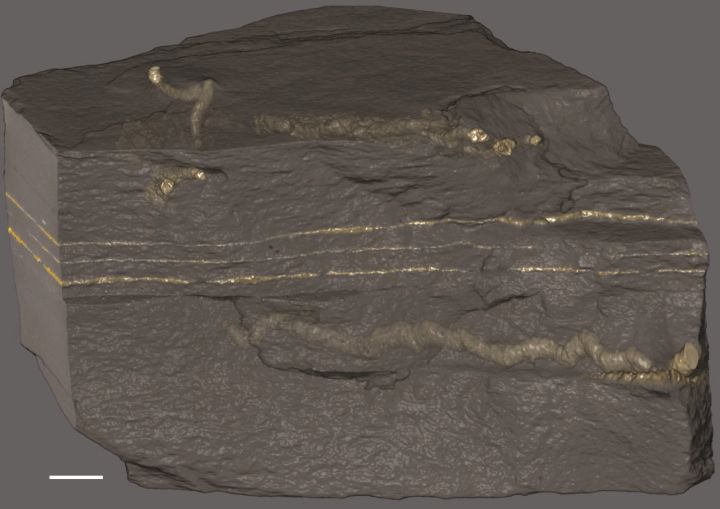A closer look at some unimaginably ancient fossils suggests complex life may have evolved much earlier and more quickly than scientists previously thought.

“If these are complex life forms, what it tells you is that evolution happened much quicker than we think,” said Kurt Konhauser, one of the authors of a paper that says tiny, slug-like beings were squirming about in the mud of shallow seas about 2.1 billion years ago.
That would push back the date at which complex life appeared by about 1.5 billion years.
READ MORE: McMaster University researchers testing origins of life theory in new planet simulator
The fossils in question, the longest of which would have been shorter than a paper clip, have been known about for years, Konhauser said. Everyone thought they were immobile — until now.
“We provide evidence that these things actually moved,” the University of Alberta professor said Wednesday.
READ MORE: Fossils found in Quebec rock could be Earth’s earliest sign of life
Watch below: (From March 2017) Microfossils found in Quebec rock may be up to 4.3 billion years old and represent the oldest-known evidence of life on Earth.

The researchers, using new techniques, found what they say are tracks in what would have been sea-floor sediments which would have been rich in bacteria that the organism probably fed on.

Get breaking National news
“You’ve got little squiggles in the sediment. Whatever it was, it was moving up and down, pushing the sediment out of its way. They’re looking for something to eat.”
READ MORE: Canadian rocks found to contain oldest known evidence of life on Earth
Scientists who study the young Earth say bacteria began to fill the atmosphere with oxygen about 2.5 billion years ago. But about two billion years ago, something happened that reduced levels of that vital gas below what was needed to support life sophisticated enough to move on its own.
It took eons to replace that oxygen. That’s why current theories suggest complex life didn’t appear until about 600 million years ago, when self-propelled multi-celled animals began to appear in the ocean.
But if Konhauser and his colleagues are right, complex life developed much earlier. And it happened quickly enough to occur in that window between the atmosphere developing adequate oxygen and whatever happened to remove it.
What were those life forms like? They weren’t complex enough to be actual animals, but they moved too much to be plants.
“We don’t really know what this was,” Konhauser said.
He suggests they may have been something like modern slime moulds, which can survive as single-celled organisms but sometimes band together in what’s called a slug phase to go from place to place in search of food.
Dense mats of bacteria would have formed in those ancient seas before there were fish to trim them. And that’s where Konhauser’s fossil creatures lived.
“These little critters are moving around, eating the organic carbon and using the oxygen.”
READ MORE: 10-year-old boy trips over 1.2M-year-old fossil while on desert hike
Watch below: (From July 2017) A 10-year-old boy’s misstep on a family hike in New Mexico has given the world a prehistoric wonder.

Until, said Konhauser, the atmosphere lost its oxygen. Chances are the beasties simply went extinct — a primordial tree of life cut down as a sapling.
“There’s no reason to think that everything we see today existed in the past. We had mass extinctions thoughout history. Why not mass extinctions then?”
It was all a very long time ago and even rocks dating back that far are rare. Theories are all we have, Konhauser said.
“We really don’t know. All we can do is speculate.”







Comments